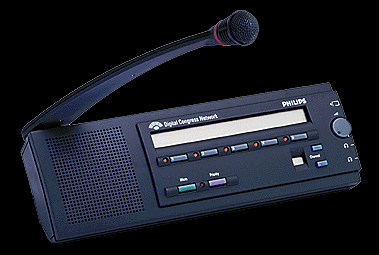Simultaneous Translation
Technical Information ...
We offer
systems to help the participants in conferences and
audiences at other events by enabling them to select the
language they wish to hear on small personal headsets.
We equip the translators with their own headphones, and
microphone, and if necessary can provide video screens to
help them follow the proceedings. Usually, the
translators will be in a separate room from the
conference, perhaps at separate desks, possibly separated
by acoustic screens. In some situations, they will
actually sit in the conference room in semi sound-proofed
booths from which they can talk without disturbing other
translators or audiences nearby.
Systems are available ranging from a single channel of
audio being routed to a single headset, (which may be
helpful in assisting the hard of hearing), up to a dozen
or more channels being routed to hundreds of delegates.
The simplest systems are often useful in situations where
an "induction loop" system might have been
favoured in the past for helping the hard of hearing, but
which is maybe unsatisfactory in terms of coverage, lack
of confidentiality or its interference with the operation
of other equipment. Unlike induction loops, though, the
infra-red system can operate on several different
channels at once. This allows several languages to be
translated at the same time.
Our Infra-Red (IR) systems operate by radiating the room
with invisible infra-red light which is modulated by the
sound to be transmitted. Due to the reflective nature of
most walls and ceilings, it is not necessary to have
unobstructed line of sight to every delegate's receiver -
if the power output of the radiating panels is adequately
over-specified, there should be good coverage of most
venues even with imperfect positioning of the radiators.
Each language is allocated a unique channel number which
is made known to all the delegates. The delegates then
select their channel on their headset that they wish to
hear.
Sometimes there may be more than one translator working
in a particular language and who each take turns in
translating. These could both speak into the same channel
so that the delegates hear an uninterrupted translation.
Various Translator desk stations are available. The
simplest are desk microphones with stereo headphones and
only one control, the TALK switch. Other translators
prefer to work with combination mic & headsets.  The most
advanced translator's stations are highly programmable
with a number of advanced features - (see picture) these
include provision to allow the translators to listen to
each other, to pass the sound picked up from the
microphones on "the floor" directly to their
channel's delegates, and to type in the name of their
language to identify themselves and their channel to the
other translators, and even to route another translation
through to their language's delegates for those cases
where two languages are very similar.
The most
advanced translator's stations are highly programmable
with a number of advanced features - (see picture) these
include provision to allow the translators to listen to
each other, to pass the sound picked up from the
microphones on "the floor" directly to their
channel's delegates, and to type in the name of their
language to identify themselves and their channel to the
other translators, and even to route another translation
through to their language's delegates for those cases
where two languages are very similar.
This sort of equipment can also be put to other uses. The
simpler infra-red systems, on just one channel and
without a translator, can provide an audio signal for the
hard of hearing. In an educational environment, the
system can provide commentary on an activity which the
students are watching, but without there being an audible
voice in the room. In investigative interviews, a single
channel system can provide an in-ear talkback to the
interviewer from an outside observer watching and
listening by CCTV